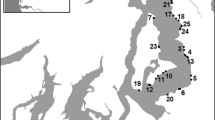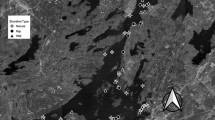Abstract
In coastal environments, the supratidal zone bridges marine and terrestrial ecosystems and is important for energy exchange. However, it is also subject to extensive anthropogenic disturbance, such as armoring of shorelines. Shoreline armoring is extensive along many coasts, but the impacts on biota are comparatively unknown. Between 2000 and 2002, paired and synoptic sampling regimes were employed to assess armoring effects on insects and benthic macroinvertebrates in the supratidal zone of Puget Sound beaches. Paired sampling showed natural beach sites had significantly more deposited wrack. Infauna was dominated by oligochaetes and nematodes; talitrid amphipods, insects, and collembolans were significantly more numerous at natural beaches, and crustaceans were more abundant at altered beaches. Insect assemblages were diverse, with taxon richness higher at natural beach sites. In the synoptic sampling, where sites with higher elevation modifications were used, there were fewer differences in invertebrate assemblages between armored and nonarmored sites. The results show that, where shoreline armoring lowers the land–sea interface, benthic infauna and insect assemblages are disrupted. Widespread shoreline modifications may decrease the availability of prey resources for fish and wildlife and decrease the contribution of organic material entering the nearshore ecosystem.







Similar content being viewed by others
References
Allan, J.D., M.S. Wipfli, J.P. Caouette, A. Prussian, and J. Rodgers. 2003. Influence of streamside vegetation on inputs of terrestrial invertebrates to salmonid food webs. Canadian Journal of Fisheries and Aquatic Science 60: 309–320.
Attrill, M.J., D.T. Bilton, A.A. Rowden, S.D. Rundle, and R.M. Thomas. 1999. The impact of encroachment and bankside development on the habitat complexity and supralittoral invertebrate communities of the Thames Estuary foreshore. Aquatic Conservation: Marine and Freshwater Ecosystems 9: 237–247.
Bousfield, E.L. 1981. Systematics and distributional ecology of beach hoppers (Amphipoda: Talitridae) of the Pacific coast of North America. Estuaries 4: 253.
Brennan, J.S., K.F. Higgins, J.R. Cordell, and V.A. Stamatiou. 2004. Juvenile salmon composition, timing, distribution, and diet in marine nearshore waters of Central Puget Sound in 2001–2002. Seattle: King County Department of Natural Resources and Parks.
Brodeur, R.D. 1989. Neustonic feeding by juvenile salmonids in coastal waters of the Northeast Pacific. Canadian Journal of Zoology 67: 1995–2007.
Burdick, D.M., and F.T. Short. 1999. The effects of boat docks on eelgrass beds in coastal waters of Massachusetts. Environmental Management 23: 231–240.
Carefoot, T. 1977. Pacific seashores. Seattle: University of Washington Press.
Chapman, M.G. 2003. Paucity of mobile species on constructed seawalls: Effects of urbanization on biodiversity. Marine Ecology Progress Series 264: 21–29.
Chapman, M.G., and F. Bulleri. 2003. Intertidal seawalls—New features of landscape in intertidal environments. Landscape and Urban Planning 62: 159–172.
Colombini, I., A. Aloia, M. Fallaci, G. Pezzoli, and L. Chelazzi. 2000. Temporal and spatial use of stranded wrack by the macrofauna of a tropical sandy beach. Marine Biology 136: 531–541.
Dethier, M. 1990. A marine and estuarine habitat classification system for Washington State. Olympia: Washington Natural Heritage Program, Department of Natural Resources.
Douglass, S., and B. Pickel. 1999. The tide doesn't go out anymore—The effect of bulkheads on urban bay shorelines. Shore and Beach 67: 19–25.
Downing, J. 1983. The Coast of Puget Sound: Its processes and development. Seattle: Washington Sea Grant, University of Washington Press.
Duffy, E.J., D.A. Beauchamp, and R.M. Buckley. 2005. Early marine life history of juvenile Pacific salmon in two regions of Puget Sound. Estuarine, Coastal and Shelf Science 64: 94–107.
Dugan, J.E., D.M. Hubbard, M.D. McCrary, and M.O. Pierson. 2003. The response of macrofauna communities and shorebirds to macrophyte wrack subsidies on exposed sandy beaches of southern California. Estuarine, Coastal and Shelf Science 58: 25–40.
Emmett, R., R. Lianso, J. Newton, R. Thom, M. Hornberger, C. Morgan, C. Levings, A. Copping, and P. Fishman. 2000. Geographic signatures of North American West Coast Estuaries. Estuaries 23: 765–792.
Folk, R. 1964. Petrology of sedimentary rocks. Austin: Hemphills.
Gray, A., C. A. Simenstad, D. L. Bottom, and T. Cornwell. 2002. Contrasting functional performance of juvenile salmon habitat in recovering wetlands of the Salmon River estuary, Oregon, U.S.A. Restoration Ecology 10: 514–526.
Groot, C., and L. Margolis. 1991. Pacific salmon life histories. Vancouver: University of British Columbia Press.
Healey, M.C. 1981. Juvenile Pacific salmon in estuaries: The life support system. Estuaries 4: 285.
Hubbard, D.M., and J.E. Dugan. 2003. Shorebird use of an exposed sandy beach in southern California. Estuarine, Coastal and Shelf Science 58S: 41-54.
Inman, D.L., and B.M. Brush. 1973. The coastal challenge. Science 181: 20–32.
Jedrzejczak, M.F. 2002. Spatio-temporal decay ‘hot spots’ of stranded wrack in a Baltic sandy coastal system. Part I. Comparative study of the pattern: 1 type of wrack vs beach sites. Oceanologia 44: 491–512.
Kitchell, J.F., L.A. Eby, X. He, D.E. Schindler, and R.A. Wright. 1994. Predator–prey dynamics in an ecosystem context. Journal of Fish Biology 45: 209–226.
Koch, H. 1989. The effect of tidal inundation on the activity and behavior of the supralittoral talitrid amphipod Traskorchestia traskiana (Stimpson, 1857). Crustaceana 56: 162–175.
Levings, C.D., and R.M. Thom. 1994. Habitat changes in Georgia Basin: Implications for resource management and restoration. Canadian Technical Report of Fisheries and Aquatic Science 1948: 330–351.
Lewis, T.L., M. Mews, D.E. Jelinski, and M. Zimmer. 2007. Detrital subsidy to the supratidal zone provides feeding habitat for intertidal crabs. Estuaries and Coasts 30: 451–458.
Macdonald, J.S., D. Simpson, B. Paulsen, J. Cox, and J. Gendron. 1994. Shoreline armoring effects on physical coastal processes in Puget Sound, Washington. Olympia: Washington Department of Ecology.
McCune, B., and J.B. Grace. 2002. Analysis of ecological communities. Gleneden Beach: MJM Software Design.
Myers, D. 2001. Integrating the science of habitat-maintaining processes into natural resource policy. Earth System Monitor 12: 9–11.
Naiman, R.J., and H. Decamps (eds.). 1990. The Ecology and Management of Aquatic-Terrestrial Ecotones. Paris and Carnforth: UNESCO and Parthenon Publishing Group.
National Research Council (NRC). 2007. Mitigating shore erosion along sheltered coasts. Committee on Mitigating Shore Erosion along Sheltered Coasts. Washington: National Academies Press.
Nelson, T.A. 2001. Species composition and controls of ulvoid algal blooms in Washington State. Journal of Phycology 37: 38–39.
Nightingale, B., and C.A. Simenstad. 2001. Overwater structures: Marine issues, 133. Seattle: University of Washington.
Nordstrom, K.F. 1989. Erosion control strategies for bay and estuarine beaches. Coastal Management 17: 25–35.
Pank, B.A. 1997. Beach hoppers: Sandy-shore custodians. Oceanorama 27: 21–24.
Pennings, S., T. Carefoot, M. Zimmer, J. Danko, and A. Ziegler. 2000. Feeding preferences of supralittoral isopods and amphipods. Canadian Journal of Zoology 78: 1918–1929.
Peterson, M.S., B.H. Comyns, J.R. Hendon, P.J. Bond, and G.A. Duff. 2000. Habitat use by early life-history stages of fishes and crustaceans along a changing estuarine landscape: Differences between natural and altered shoreline sites. Wetlands Ecology and Management 8: 209–219.
Polis, G.A., and S.D. Hurd. 1996. Linking marine and terrestrial food webs: Allochthonous input from the ocean supports high secondary productivity on small islands and coastal land communities. American Naturalist 147: 396–423.
Rice, C.A. 2006. Effects of shoreline modification on a northern Puget Sound Beach: Microclimate and embryo mortality in surf smelt (Hypomesus pretiosus). Estuaries and Coasts 29: 63–71.
Romanuk, T.N., and C.D. Levings. 2003b. Cascading effects of removal of marine supralittoral vegetation on arthropod communities and juvenile salmonids. American Society of Limnology and Oceanography, Aquatic Sciences Meeting, Salt Lake City, Utah.
Romanuk, T.N., and C.D. Levings. 2003. Associations between arthropods and the supralittoral ecotone: Dependence of aquatic and terrestrial taxa on riparian vegetation. Environmental Entomology 32: 1343–1353.
Romanuk, T.N., and C.D. Levings. 2005. Stable isotope analysis of trophic position and terrestrial vs. marine carbon sources for juvenile Pacific salmonids in nearshore marine habitats. Fisheries Management and Ecology 12: 113–121.
Savard, J.-P., L.P. Clergeau, and G. Mennechez. 2000. Biodiversity concepts and urban ecosystems. Landscaping and Urban Planning 48: 131–142.
Schlacher, T.A., D.S. Schoeman, J. Dugan, M. Lastra, A. Jones, F. Scapini, and A. McLachlan. 2008. Sandy beach ecosystems: key features, sampling issues, management challenges and climate change impacts. Marine Ecology 29: 70–90.
Shreffler, D., C. Simenstad, and R. Thom. 1992. Foraging by juvenile salmon in a restored estuarine wetland. Estuaries 15: 204–213.
Simenstad, C.A., B.S. Miller, C.F. Nyblade, K. Thornburgh, and L.J. Bledsoe. 1979. Food web relationships of Northern Puget Sound and the Strait of Juan de Fuca: A synthesis of the available knowledge, 335. Seattle: Fisheries Research Institute, College of Fisheries, UW.
Simenstad, C., K. Fresh, and E. Salo. 1982. The role of Puget Sound and Washington coastal estuaries in the life history of Pacific salmon: An unappreciated function. In Estuarine comparisons, ed. V. Kennedy, 343–364. New York: Academic.
Simenstad, C.A., C.T. Tanner, R.M. Thom, and L.L. Conquest. 1991. Estuarine habitat assessment protocol. Seattle: US Environmental Protection Agency, Region 10.
Simenstad, C.A., M.N. Dethier, C.D. Levings, and D.E. Hay. 1997. The terrestrial/marine ecotone. In The rainforests of home, ed. P.K. Schoonmaker, B. VonHagen, and E.C. Wolf, 149–188. Washington, DC: Island Press.
Tanner, C.D., J.R. Cordell, J. Rubey, and L.M. Tear. 2002. Restoration of freshwater intertidal habitat functions at Spencer Island, Everett, Washington. Restoration Ecology 10: 564–576.
Toft, J.D., J.R. Cordell, C.A. Simenstad, and L.A. Stamatiou. 2007. Fish distribution, abundance, and behavior along city shoreline types in Puget Sound. North American Journal of Fisheries Management 27: 465–480.
Toweil, D.E. 1974. Winter food habits of river otters in western Oregon. Journal of Wildlife Management 38: 107–111.
Vermeer, K. 1982. Comparison of the diet of the glaucous-winged gull on the east and west coasts of Vancouver Island. The Murrelet 63: 80–85.
Washington Department of Natural Resources. 1999. Washington State Shorezone Inventory CD. Olympia: Nearshore Habitat Program.
Wentworth, C.K. 1922. A scale of grade and class terms for clastic sediments. Journal of Geology 30: 377–392.
Zar, J.H. 1999. Biostatistical analysis. Upper Saddle River: Prentice Hall.
Zimmer, M., S.C. Pennings, T.L. Buck, and T.H. Carefoot. 2002. Species-specific patterns of litter processing by terrestrial isopods (Isopoda: Oniscidea) in high intertidal salt marshes and coastal forests. Functional Ecology 16: 596–607.
Acknowledgements
We thank C. Rice, J. Gregg, M. Nelson, and the Wetland Ecosystem Team for field and lab support. M. Dethier and B. Miller provided comments on early drafts of the manuscript. R. Latour provided help with statistical analysis, and three anonymous reviewers provided suggestions that strengthened the final version. Support for this project was provided by King County, Washington Department of Natural Resources, US Army Corps of Engineers Seattle District, NOAA Fisheries NWFSC, and the University of Washington School of Aquatic and Fishery Sciences.
Author information
Authors and Affiliations
Corresponding author
Rights and permissions
About this article
Cite this article
Sobocinski, K.L., Cordell, J.R. & Simenstad, C.A. Effects of Shoreline Modifications on Supratidal Macroinvertebrate Fauna on Puget Sound, Washington Beaches. Estuaries and Coasts 33, 699–711 (2010). https://doi.org/10.1007/s12237-009-9262-9
Received:
Revised:
Accepted:
Published:
Issue Date:
DOI: https://doi.org/10.1007/s12237-009-9262-9




